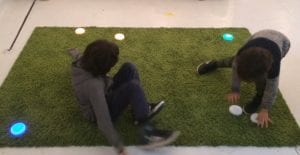What is it?
This is a set of up to six large, white, plastic, buttons linked, via Bluetooth, to an iPad app. The buttons are switches, when pressed they make something happen. They can change colour and are touch sensitive, so the amount of pressure needed to trigger a response can be varied. Put together they provide myriad ways of working with pupils with SEND, whilst offering lots of fun to those without any learning needs, too.
Using the app, these switches can be programmed to become musical, each playing a note, or a sample of music when pressed. Perhaps each press plays the next part of a known song, or they light up in sequence to show the next note. As they are Bluetooth they can be positioned anywhere. That might be on the tray of a wheelchair, or dotted around a room to encourage movement.
They can also be used for other activities, such as memory games where players follow a sequence, team or individual challenges to find the next colour or note. All sorts of games and activities are possible. And beyond that, they are available to be used simply as switches, connected to laptops and computers to control what’s happening on screen.
Who is it for?

Initially they were intended for pupils with more complex SEND to join in with music lessons, however, they could be used by those with a very wide range of learning needs, and none. They can improve curriculum access for some, but also provide hours of fun for all, with children and young people working and playing side by side regardless of needs or abilities.
How do I use it?
The buttons, Cosmoids, come with a free iPad app. The simplest thing to do is to scroll through the games and activities, select the one you want, and play it. The settings will automatically be loaded onto the switches. However, you can also configure each one separately, adjusting colour, sensitivity, and response. It is very easy to get started, but with options to make that make usage almost unlimited.
What else is there?
Very little. In the area of music and disability there is Skoog http://skoogmusic.com a polyutherane cube that triggers midi files when squeezed.  Also a clever device and one that is proving useful for access in all sorts of settings.
Also a clever device and one that is proving useful for access in all sorts of settings.
There are also Bluetooth and wireless switches available from companies such as Inclusive Technology http://www.inclusive.co.uk . Although some can be a bit flaky in operation, dropping their connections and needing re-configuring. Cosmo is pretty stable.
More information can be found at, https://www.filisia.com/cosmo .




